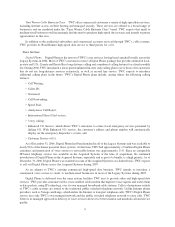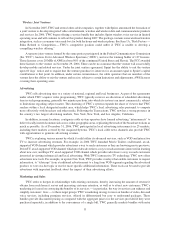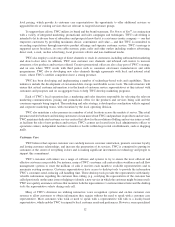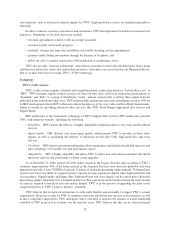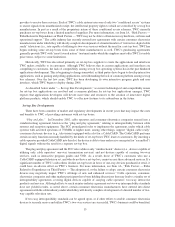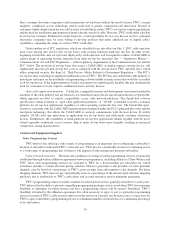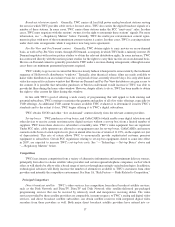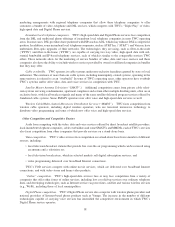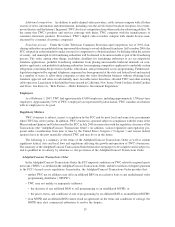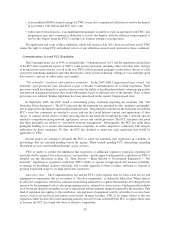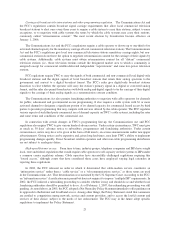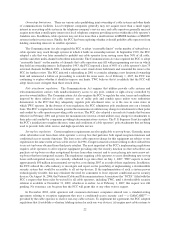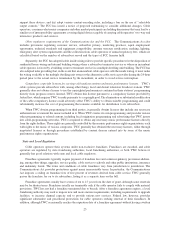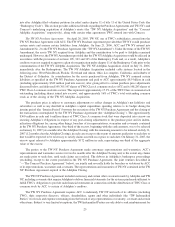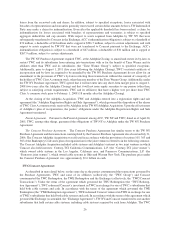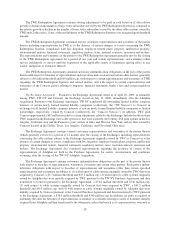Time Warner Cable 2006 Annual Report Download - page 23
Download and view the complete annual report
Please find page 23 of the 2006 Time Warner Cable annual report below. You can navigate through the pages in the report by either clicking on the pages listed below, or by using the keyword search tool below to find specific information within the annual report.marketing arrangements with regional telephone companies that allow these telephone companies to offer
customers a bundle of video, telephone and DSL services, which competes with TWC’s “Triple Play” of video,
high-speed data and Digital Phone services.
Incumbent local telephone companies. TWC’s high-speed data and Digital Phone services face competition
from the DSL and traditional phone offerings of incumbent local telephone companies in most TWC operating
areas. In some cases, DSL providers have partnered with ISPs such as AOL, which may enhance DSL’s competitive
position. In addition, some incumbent local telephone companies, such as AT&T Inc. (“AT&T”) and Verizon, have
undertaken fiber-optic upgrades of their networks. The technologies they are using, such as fiber-to-the-node
(“FTTN”) and fiber-to-the-home (“FTTH”), are capable of carrying two-way video, high-speed data with sub-
stantial bandwidth and IP-based telephony services, each of which is similar to the comparable services TWC
offers. These networks allow for the marketing of service bundles of video, data and voice services and these
companies also have the ability to include wireless services provided by owned or affiliated companies in bundles
that they may offer.
Cable overbuilds. TWC operates its cable systems under non-exclusive franchises granted by state or local
authorities. The existence of more than one cable system, including municipality-owned systems, operating in the
same territory is referred to as an “overbuild.” In some of TWC’s operating areas, other operators have overbuilt
TWC’s systems and/or offer video, data and voice services in competition with TWC.
Satellite Master Antenna Television (“SMATV”). Additional competition comes from private cable televi-
sion systems servicing condominiums, apartment complexes and certain other multiple dwelling units, often on an
exclusive basis, with local broadcast signals and many of the same satellite-delivered program services offered by
franchised cable systems. Some SMATV operators now offer voice and high-speed data services as well.
Wireless Cable/Multi-channel Microwave Distribution Services (“MMDS”). TWC faces competition from
wireless cable operators, including digital wireless operators, who use terrestrial microwave technology to
distribute video programming and some of which now offer voice and high-speed data services.
Other Competition and Competitive Factors
Aside from competing with the video, data and voice services offered by direct broadcast satellite providers,
local incumbent telephone companies, cable overbuilders and some SMATVs and MMDSs, each of TWC’s services
also faces competition from other companies that provide services on a stand-alone basis.
Video competition. TWC’s video services face competition on a stand-alone basis from a number of different
sources, including:
• local television broadcast stations that provide free over-the-air programming which can be received using
an antenna and a television set;
• local television broadcasters, which in selected markets sell digital subscription services; and
• video programming delivered over broadband Internet connections.
TWC’s VOD services compete with online movie services, which are delivered over broadband Internet
connections, and with video stores and home video products.
“Online” competition. TWC’s high-speed data services face or may face competition from a variety of
companies that offer other forms of online services, including low cost dial-up services over ordinary telephone
lines, and developing technologies, such as Internet service via power lines, satellite and various wireless services
(e.g., Wi-Fi), including those of local municipalities.
Digital Phone competition. TWC’s Digital Phone service also competes with wireless phone providers and
national providers of Internet-based phone products such as Vonage. The increase in the number of different
technologies capable of carrying voice services has intensified the competitive environment in which TWC’s
Digital Phone service operates.
18



